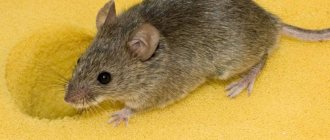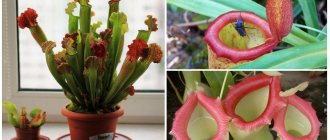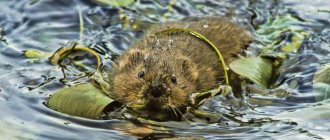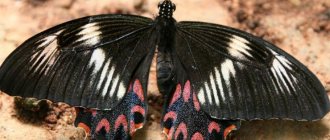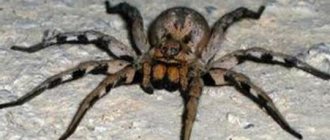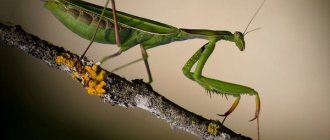Why do insects imitate wasps?
Wasps, in order to feed and raise their offspring, are forced to hunt. They are able to attack even insects that are smaller in size. Their powerful jaws and the poison they inject into their prey help them cope with their prey. Due to the predatory characteristics of wasps, many representatives of the fauna are afraid of them and prefer to stay away from dangerous predators. The weaker imitators took advantage of this.
There is also a hypothesis, confirmed by research, that for some insects that mimic wasps, the camouflage color protects them directly from the models themselves. A striking example of this: the predatory South American wasps and the peaceful moth moths, which exactly imitate them, and not every specialist can distinguish them. During observations, it was noticed that the wasps did not attack their own kind.
There are many insects similar to wasps in the world. Let's consider the most interesting and prominent representatives.
Why are wild wasps dangerous?
Almost all wild wasps are capable of stinging quite painfully. At the same time, the strength of its bite and possible consequences for humans depend on the biology of the insect:
- for example, it would seem that large and terrible scolia sting relatively weakly and with virtually no serious consequences, since their venom is intended primarily to immobilize already inactive and harmless prey.
- But the venom of many species of hornets is so strong that it causes extensive swelling and very acute pain. Sometimes an allergic reaction to such a bite can lead to anaphylactic shock and death. Huge tropical hornets are especially dangerous in this regard - several simultaneous bites can cause internal bleeding.
Among the wasps there is also an insect with one of the most painful bites in the world: the road wasp Pepsis elegans, whose main prey is tarantulas, is considered the second most painful insect in the world after the South American bullet ant.
Hornets and bees
Hornets are omnivorous in nature. They feed mostly on the sweet pulp of various fruits, but they are also predators. These giant wasps feed their larvae with caught and killed insects, while the adults themselves are not averse to snacking on a caught beetle or bee.
To a greater extent, these are very useful creatures for humans. A colony of these striped hunters that settles next to a gardener’s home can protect the crop from most harmful insects. Hornets are at the top of the invertebrate food chain and can bring half a kilogram of live food per day to feed themselves and their larvae.
But in an apiary environment, the benefit of these predators ends. Hornets are a real beekeeper's scourge. The bee and the hornet are the prey and the hunter. Hornets and bees are long-standing and primordial enemies, because one of the main hunting objects for this giant wasp is the honey worker. Fed on killed bees (and wasps as well), their larvae receive all the necessary nutrients they need for development.
Bees are practically defenseless against hornets. If a scout wasp notices the presence of a bee hive on the territory, without protective measures on the part of the beekeeper, the hive is doomed. Even one huge hornet can destroy dozens of bees, crushing them with its jaws and using a deadly sting.
The main goal of a hornet invasion of a hive is not the bees themselves, but the honey. The sweet substance is a real wealth for wasps; it can feed the entire colony in abundance.
Bees have only one effective method to deal with one hornet. By attacking a wasp in a swarm and enclosing it in a continuous living vibrating “cocoon,” the bees can kill the enemy by creating overheating conditions for him inside this trap, created from the bees themselves, constantly moving around the wasp.
Features of the genus
So who are the hornets? The genus Hornets belongs to the family of true wasps. That is why representatives of this genus fit well into the external framework inherent in ordinary wasps. At the same time, there are some differences that will not allow these, albeit close, but still different taxonomic groups of Hymenoptera insects, to be confused.
What does a hornet look like next to a wasp? Large hornets differ from other wasps primarily in their large size. The dimensions of an insect such as a hornet range from 1.8 to 5.5 cm in length, depending on the species. Also, the wingspan of these largest wasps in the world can reach 8 cm. And this large wasp, in addition to its serious dimensions, has very powerful and impressive jaws, which also differs from most other wasps.
Among the differences between representatives of the hornet genus and other wasps, some differences in color should also be mentioned. The hornet insect has the same striped abdomen as most wasps. Moreover, if the color of the wasp is dominated by only two colors, namely black and yellow, then the color of the hornet is somewhat darker, and orange and brown shades have found their place in the color palette.
Well, we cannot ignore that unpleasant part of the story about this huge wasp, which concerns the main weapon of these stinging hymenoptera. It’s no secret that wasps tend to use their sting for its intended purpose in case of danger.
Although, it must be said that the wasp’s sting performs not only the function of an injection needle for treating a presumptuous enemy with a portion of poison. It is also a reduced insect ovipositor.
The sting of this insect is longer than that of a common wasp, and delivers a greater dose of venom than a bee, bumblebee or most wasps, making this miniature "tiger" a formidable opponent for any living creature that provokes its wrath.
Therefore, such cinematic epithets as “murder hornets” are often and, it must be said, not unreasonably used in relation to these not very cocky, but certainly capable of standing up for themselves insects.
Characteristics of wasps and their way of life
These insects are aggressive in nature and attack the source of irritation first. At the same time, wasps not only sting, but also bite. A wasp sting will cause less pain than if it stung.
Wasps are extremely caring towards their offspring, this is more clearly expressed in wasps of the social species, and representatives of solitary wasps only care about their own larvae.
In order for the larvae to be full, the wasps bring them paralyzed prey, and the larvae can safely feed on it for a long time. In social animals, care for larvae is structured more complexly - according to the hierarchy in the family.
In a swarm, all young wasps go through a “working” stage - first they become cleaners, then they can be “promoted” to nurses.
These insects can easily find their nests, even if they have flown several kilometers away from them, but if, in the absence of a swarm, the nest is moved just a few meters, it will be very difficult for the insects to find it.
Hover flies
Hoverflies, also known as syrphids, are a large family with about 6,000 species. Some of them look more like bees, others like wasps, and others like bumblebees. They live everywhere, with the exception of Antarctica, desert areas and tundra. They got their name because of the characteristic sound made by their wings.
Interesting! Syrphidologists study hoverflies. They even hold special symposiums dedicated to fly research.
A striped insect, similar to a wasp, absolutely harmless to humans. It can often be found in plantings of dill, carrots, parsley, and flowering plants in the garden. Adult hoverflies feed exclusively on flower nectar and pollen and occupy an honorable place among pollinating insects
Lifestyle, nutrition, reproduction
Adult insects are very maneuverable and can change direction to the exact opposite very abruptly. Thanks to the rapid movement of its wings, the fly often hovers in one place and seems to hover in the air above the flowers, as if choosing which one has the most delicacy.
The larvae are voracious, and the older they get, the more and more actively they eat. They feed mainly on small insect pests - caterpillars, psyllids, spider mites, small butterflies and aphids. They literally suck the latter alive. One syrphid larva can suck up to 200 aphids in one day, and one can imagine how a whole brood of such larvae will benefit the garden. It is on plants affected by aphids that one can often notice a cluster of syrphid larvae. In addition, the larvae can be localized in the nests of other insects, rotten rotting wood, and on large plants.
In the larval stage, flies hoverflies and overwinter. In the spring, pupae appear from them, and by the end of June, young adults appear, starting their years already in July.
During the period of courtship with females, males hover in the air above them and make a sound similar to gurgling. A similar, but slightly different sound can be heard from syrphids at other times, hence their popular name - hoverflies. Mating of these flies can occur right in the air. Also, while hovering, males protect their territory, driving away rivals.
What do hoverfly larvae eat?
Syrphid larvae look like small leeches. They are distinguished by a wrinkled body of yellow or greenish color. They have no legs and are not particularly mobile. They feed on aphids, insect eggs, and spider mites, which bring considerable benefits to agricultural land. A caring mother syrphid lays eggs directly in the aphid habitat.
However, not all hoverfly larvae prefer to see garden pests on their menu. The food preferences of all species are very diverse. Some of them are purely vegetarians and eat only plant tissue. The most exotic representatives process manure or wood.
Striped fly
Temnostoma wasp is a large fly from the hoverfly family, very similar to a wasp. On a long body (up to 18 mm) there are 2 transparent wings. In the center of the dark head there is a shiny stripe and reddish mustache. There are thin golden hairs on the chest and scutum. The oval abdomen is covered with transverse yellow-black lines.
Attention! Sometimes the marks merge, leaving a narrow brown spot.
Wasp-like flies live in deciduous forests where there is a lot of rotting vegetation. Found in river valleys and mountains. Temnostoma axialis is common in:
- Europe;
- Asia;
- North Africa;
- Greenland;
- America.
Where does the wasp spider (Argiope Brünnich) live?
The wasp spider is a fairly numerous species. It is widespread in the countries of North Africa, Asia Minor and Central Asia, India, China, Korea, Japan and the USA. It is also a common arachnid in Central and Southern Europe, Kazakhstan, Crimea and the Caucasus. In Russia, the spider wasp was noticed in several regions: Chelyabinsk, Saratov, Ulyanovsk, Tambov, Oryol, Lipetsk, Penza and Bryansk. Probably due to the increase in average annual air temperature, Argiope Brünnich also began to be noticed in the Tula, Ryazan regions and in the Moscow region. According to the latest data, the black and yellow wasp spider began to appear in the Kaluga region, as well as in the Novgorod region on the territory belonging to the Rdeisky Nature Reserve.
The wasp spider's favorite habitats are located in areas exposed to the sun: fields, lawns, along roadsides, forest clearings and forest edges. The black-and-yellow striped wasp spider places its hunting nets on various low vegetation, giving particular preference to xerophilous plants growing in particularly dry areas of the area.
A unique feature of all orb weavers, including the wasp spider, is their ability to move considerable distances thanks to their web threads, picked up by rising air currents. This manner of settlement has led to the fact that some southern populations often end up in northern territories.
Photo credit: EapClochydd
Predator
A black insect that looks like a single ground wasp. The bug has an elongated body and mustache. Similarities with a wasp are found due to its striped abdomen. The upper part is covered in black, covered with wings, and wide black and yellow stripes are clearly visible below.
The predator bug itself is a predator; it easily attacks even poisonous spiders. Distributed everywhere. The brightest representatives live in tropical countries. It is active at night and remains hidden during the day.
Some species feed on the blood of humans and warm-blooded animals and are subject to destruction. Most of them attack insects and spiders. It has great endurance. It can sit in hiding for a long time, waiting for prey. As soon as he sees her, he immediately rushes to attack. Sticks the proboscis, launches a toxic substance. The poison instantly paralyzes the victim.
The same behavior is observed in road and ground wasps. These representatives of the wasp family are called predators due to the need to lay eggs in the body of the prey. The larvae dig into the belly and eat away from the inside. Until the end of the cycle, only the shell remains of the beetle, spider, and large larvae.
Insect copycats
A black insect that looks like a wasp is a predator. Outwardly, it has much in common with predatory road wasps, capable of preying even on poisonous spiders.
Unlike its predecessors, the predator does not need to mimic wasps. He himself is a predator, feeding on insects and larvae. Some tropical species have a preference for human or mammalian blood. They spend the daytime in shelter and go hunting at night. They are distinguished by their remarkable endurance and are able to wait for their prey for several hours.
At the sight of prey, the predatory bug makes a sharp lunge, pierces its proboscis and injects poisonous enzymes. Then it’s a matter of technique and it’s not difficult for an insect to cope with an immobilized object. The hunting process is similar for the road wasp.
It is impossible not to mention another black insect, similar to a wasp. This is a representative of the longhorned beetles, Plagionotus. Its dark body is generously covered with yellow spots and stripes, which allows the beetle to sit imposingly in flowers, without fear of competition from wasps or bees.
The striped beetle feeds on nectar and takes part in pollinating flowers. In case of danger, it begins to quickly flap its wings, thereby increasing its resemblance to a wasp.
How to get rid
A wasp sting is most dangerous for children and people with individual intolerance. If the insect nest is located close to your home, then it is better to get rid of it. This can be done both with the help of chemicals and using a mechanical method of control.
Chemical control
Most often, chemicals can be found in aerosol form. The concentrated insecticide does not poison the ground and is practically safe for people.
Most Popular:
- Moskitol. It is necessary to spray strictly in an open space. If you need to spray the hole, then reduce the dose by 2-3 times.
- Gett. A powerful, odorless drug. It has a long-lasting effect, as it remains active for 5-6 months after spraying.
Karbofos and Troapsil are no less popular.
Physical methods
The nest should be removed from the property wearing a protective suit or after pre-treating the area with chemicals. If the nest is located in the ground, then you can dig up the area and pour boiling water over it.
When it is necessary to lure out adults, sweet traps are used. They are made from a plastic bottle and compote or fruit juice. The bottle is cut in half and the upper part is placed neck down into the lower part, where the sweet liquid is poured.
How wasps arrange their homes
The queen wasp begins building a nest; to begin with, she only needs a dwelling the size of a walnut - there she will lay her first clutch of eggs. She builds only one layer of the nest, then gradually builds on the next.
She will begin to build the nest herself until the worker wasps hatch from the first clutch, which will continue their work, completely freeing her for further procreation and increasing the number of livestock in the swarm.
Wasps of a single species build their homes in their own way. This may be a small cell located in a place where prying eyes will not penetrate and precipitation will not fall.
For example, pottery wasps build dwellings from natural mud, shaped like a vase; structures are attached to tree branches or to the walls of human buildings.
Some wasps make homes in plant stems they have bitten through or dig holes in the soil. A single wasp can settle in any small crack located on a piece of thick cardboard, or in gardening gloves forgotten and lost in the garden.
The peculiarity of solitary wasps is that having laid a clutch, they seal it, and there is no interaction between adults and larvae.
There is an observation that from those cells that are smaller in size than the others, male larvae hatch, which means that the males are smaller in size than the females.
Butterflies in the form of wasps
A large insect that looks like a wasp may turn out to be quite an ordinary glass butterfly. However, this is not the only remarkable thing about the airy fluttering creatures. Most of them are distinguished by transparent wings. And if not for the contrasting border, it would be impossible to visually determine the presence of wings.
The most common species in the European part are poplar, currant, and apple. The insect is associated with the wasp exclusively by its bright yellow striped body color and flight style. Otherwise, it is a typical garden pest. The female lays eggs under bark scales near the buds. After a few days, caterpillars emerge from them, gnaw holes in the shoots and penetrate deep into the plant. They gnaw out the core, gradually descending to the base of the tree or bush. After wintering, they continue to eat the plant from the inside. And although an insect similar to a wasp does not bite a person, its harmfulness is significant. The offspring are located inside the trunks and branches, so the emerging pest can only be dealt with in a radical way - by pruning and destroying the affected areas.
An interesting picture is presented by the mating games of glass butterflies. The males gather in a circle near the female and begin to flutter around the lady, as if surprising her with their abilities and showing themselves in all their glory. The female can only choose the individual she likes.
Climaciella brunnea
The insect is very similar to a wasp, with a long body, and has huge limbs like a praying mantis. A representative of the mantispid family can be recognized by its thin, graceful body, colored brown with yellow horizontal stripes. Predators have well-developed enlarged front legs, which they use to grab prey. Males live only in the spring before mating.
Life cycle of a queen hornet
Despite the fact that the queen lives no more than a year, during this period she manages to lay hundreds of eggs.
Her life follows a certain cycle. Viable young females appear in the hive in late summer and early autumn. Together with them, males born from unfertilized eggs also grow up. By that time, the colony has reached its maximum size. There can be several hundred hornets in a nest. Mature females and males leave the home to mate. After this, the males die, and the seed transferred to the female is stored in a special section. It will be stored until winter is over.
In November, life in the hive calms down, because almost all the workers die. Old housing will not be reused. Once the colony survives the cold months and emerges, it will begin building a new home for the family. Not all insects manage to survive until spring.
Hornets usually hide in:
- walls of wooden buildings;
- cracks;
- in tree hollows or under their bark.
Nutrients accumulated during the autumn months are used sparingly due to the transition of the insect body into diapause. This period is characterized by a slow metabolism.
For it to occur, two conditions are necessary: a decrease in daylight hours and a decrease in air temperature. Diapause increases the hornets' body's ability to withstand any external influences. But this condition does not save females from potential predators. Insects hiding in tree hollows are often discovered by mammals and birds, which subsequently eat them.
A suitable option in this case might be:
- areas under the roofs of residential buildings;
- tree hollows;
- birdhouse;
- depression in the soil.
To make the first comb for laying eggs, the queen collects tree bark and chews it. She usually arranges from 40 to 50 cells. Alone, she can make a nest the size of half a soccer ball. The female lays eggs purposefully. The peculiarity is that some of them are fertilized, while others are not. From the former, females emerge, which can later turn into queens, and from the latter, working individuals are born.
Red Reaper Ant: 3.0
The red harvester ant provides a great service to farmers as it eats many pests. These ants have a nearly square head with a relatively long body without a spine, and their reddish-orange color distinguishes them from other ant species. The positive thing is that they attack rather reluctantly, although they do have a painful sting. Schmidt describes the sting from these ants as bold and relentless, and the bite feels like drilling out an ingrown toenail. According to the Pain Index, the pain of a red harvester ant bite is 3.0.
Harm from a murmuring fly
The daffodil fly, or the murmuring fly, causes great damage to the bulbs of daffodils, tulips, hyacinths, gladioli, and the rhizomes of irises.
Before winter, larvae that have not gone through three stages of development are buried in the ground near bulbous plants and overwinter in the bulbs. They eat away the inside of the bulb, and if the plant does not die, then in the spring it grows extremely slowly and does not bloom.
The pest does not like peat, so one of the methods of plant protection is to mulch the planting with peat.
Infected plants can be watered with a solution of pine flour powder, and it is recommended to heat-treat the planting material during the washing and drying process.
Bee
Insects similar to wasps are bees. They are extremely often confused with each other. A bee and a wasp have some similarities in their lifestyle, they even sting just as painfully. The bee has a round shape, the head and chest are gray-black with thick, long yellow hairs. Massive paws, long whiskers are clearly visible. A striking distinctive feature is the absence of a “wasp waist” - a thin bridge between the chest and abdomen. The color is yellow-black, but the stripes are narrower and covered with yellow hairs.
Bees feed exclusively on nectar and form honeycombs from wax, which they produce themselves. Thanks to their ability to reproduce honey, they have long been domesticated and live in beehives. They are periodically attacked by the wasp family. This fact refutes the statement that wasps do not attack their own kind. The similarity in color must be explained by something else
Is the wasp spider poisonous or not?
The arthropod has poisonous glands that produce a toxic substance. When it enters the victim's body, it causes muscle spasm and immobilization. The poisonous brunette is not distinguished by its aggressive disposition and does not attack unnecessarily. For humans, its presence nearby does not pose a danger. However, if the argiope feels a threat to its own life, an attack and a spider bite will follow.
Due to its unusual color, wasp spiders are kept at home as pets. They live in specially equipped aquariums and feed on insects. Feeding should be done every other day. Spiders live in an apartment for up to 1.5 years.
Longhorn beetle
Imitates the color of Plagionotonus wasps, a representative of longhorned beetles. Outwardly it resembles a bug. Hard chitinous cover, oblong body, head clearly visible, very long, curled mustache. There are no transparent wings, the insect rarely flies. Color black and yellow with stripes.
The body length of an adult reaches 22 mm. The female lays eggs in the wood. During its entire life it reproduces about 100 thousand of its own kind. The larvae gnaw through numerous tunnels and damage the tree. Transformation into an adult takes a long time - up to 10 years. A typical representative of pests with which humans wage a merciless fight.
An insect that closely resembles wasps is a representative of the same family - the hornet. The largest species, characterized by aggressive behavior. Destroys wasp and bee hives. The size of the body reaches 3 cm, the average wasp is 1.5 cm. Massive body, powerful jaws, strong limbs. The giant wasp bites painfully and the venom causes severe allergies.
Wasps are unique insects whose lifestyle, behavior, and physiological abilities are a constant object of study. Insects that have external similarities with them are no longer similar.
Social structure and reproduction
Photo: Argiope Brünnich spider
Females are ready to enter into mating relationships after molting. Most often this happens with the onset of the autumn season. It is after the end of molting that the female’s mouthparts remain soft for some time, which leaves the males a chance to survive after mating. However, this does not always help males survive. To lay eggs, females vitally need protein, the source of which can be a partner.
Before mating, males look closely for a long time and choose the female they like. They have been nearby for some time. When the male approaches the potential partner he likes, the threads of the trapping net do not vibrate, as when prey hits them, and the female understands that the time has come for mating. Males tend to “clog” the chosen female so that no other contenders can fertilize her.
About a month after mating, the spider lays eggs. Before this, she weaves one or several cocoons, in each of which she lays about four hundred eggs. After the cocoons are filled, the female fixes them near her web using reliable, strong threads.
Interesting fact: After the eggs are hidden in cocoons and securely fixed on twigs or other types of vegetation, the female dies.
The eggs survive the winter in these cocoons. Spiders hatch from eggs only in spring. From childhood, individuals of this species experience fierce competition for survival. The lack of food in the limited space of the cocoon encourages stronger spiders to eat weaker and smaller ones. Those who survive get out of the cocoon and climb higher onto various types of vegetation. They lift their abdomen up and release a web. Along with the wind, cobwebs and spiders are carried in a variety of directions. The full life cycle of a spider averages 12 months.
Rider
An insect with a long body and a sting makes many puzzle over the name of this creature. The wasps are solitary wasps. They do not build typical nests and do not swarm. Distributed everywhere, including many genera and species. They differ in color and body length. Some have no wings at all, more like an ant.
The most striking representative is the equestrian with a long tail. An elongated black body, high limbs, narrow wings, and a sting. Unlike other wasps, ichneumon wasps use a sting to lay eggs. They pierce the victim’s body, inject poison, and lay their offspring. This is where the female's mission ends. The larvae develop independently. The victims include spiders, beetles, butterflies, and larvae of large insects.
About appearance
Before you start exterminating the soldiers, you need to better understand what the bug looks like externally. Here are the main characteristics of the red bug's appearance:
- The body of bedbugs of this species is painted in bright red shades.
- The shell has a characteristic black pattern.
- Sometimes in nature there are other varieties of the soldier bug, in which the shell is painted in yellow shades with the same black pattern on top, on the wings.
Determining the presence of a soldier bug on a personal plot is not difficult, because every person has probably seen these insects on hot summer days.
Many people confuse the soldier bug with a similar insect, the firefighter beetle. This is probably why soldiers are often called beetles. Although from the outside the difference between insects is noticeable to the naked eye. The firefighter beetle has an oblong body shape, while the soldier beetle has an oval and slightly flattened body shape. The soldier bug belongs to the category of pests and cannot fly at all. In addition, an insect with a brightly colored body leaves behind an unpleasant odor. The fire beetle has the same bright appearance, but at the same time it can fly (albeit slowly) and, unlike bedbugs, protects the garden from pests.
Habitats
Black wasps can live almost anywhere except in extremely harsh climates. Since insects live in the ground, it is important for them to find loose soil suitable for digging, but at the same time, the soil should not crumble, otherwise the home will be unstable. Wasps usually settle in a mixture of clay, sand and limestone; it is this composition that provides all the needs of insects.
In Russia, the earthen species can be found in fields, forests, near roads, in gardens, vegetable gardens, and summer cottages.
Black insects often settle near residential buildings. In the homestead, wasps destroy flies and spiders and pollinate plants, thereby providing significant assistance to humans.
- Cryptochilus ringed lives in Central Asia, Crimea, and Transcaucasia. Loves rocky areas. These wasps are distinguished by orange wings and yellow stripes on the abdomen.
- The tarantula hawk inhabits South America. This is a very large wasp, 5 cm long, and the sting reaches 7 mm. The larvae of such pompilids mature longer than those of other earth wasps and feed on the body of a poisonous tarantula.
- The red-bellied road wasp is found in central Eurasia. Its abdomen is covered with red spots, which is where this species gets its name. The larvae are fed by the wolf spider.
Damage caused by glassware
Apple glass beetles are dangerous pests. Adult moths attack various stone and pome crops. They live in the space between the bark and the wood itself. In trees, caterpillars make long, winding passages.
These butterflies damage garden plants: shrubs and trees.
Currant glass damages currants and gooseberries. It eats away the core of the branch. In the first year of damage, the currant branches do not change much. The fact that the pest has infected the plant is indicated by fruits and leaves that become small. Damaged branches wither and dry out. This occurs during the feeding period of older caterpillars.
If you find an error, please select a piece of text and press Ctrl+Enter.
Lifestyle and habitat of carpenter bumblebees
The carpenter bumblebee is a heat-loving insect, this explains its habitat, which includes:
- Southern Europe;
- Near East;
- Türkiye;
- southern and western regions of Russia;
- Ukraine;
- Belarus;
- Crimea;
- Caucasus.
The bumblebee summer begins in mid-spring and lasts until the end of September. Insects make nests in wood. These could be dried tree trunks or branches, poles, or wooden buildings. Insects gnaw passages up to 30 cm long, in which they form a dwelling of 10 - 12 adjacent cells. The partitions between the cells are made of wood chopped by a bumblebee.
Carpenter bumblebees prefer to settle in open spaces, always choosing the sunny side. Insects live either alone or in small colonies consisting of only females, preferring silence and solitude. They settle in the vicinity of people only out of necessity, when there is no other suitable place nearby for housing and building a nest.
How to deal with pests in the house?
There are several ways to combat this pest:
- The first way is humane. You can simply scare away insects. This method is characterized by the fact that the insect does not die, but only leaves your garden, as unfavorable conditions are created for its existence. Experienced gardeners know that these pests are afraid of vinegar and boric acid. You can also use garlic or onion infusion and laundry soap. The liquid is sprayed over the beds, sprinkled on flower pots;
- The second method completely destroys insects. This is the use of chemicals such as Iskra, Inta-vir, Karate and other chemicals to kill insects. The main thing is to follow the instructions on the package;
- To prevent these villains from visiting your garden, it is worth clearing it of garbage, rotting plants, and the like;
- Digging in the fall will also help you fight not only earwigs, but also other pests and weeds. Never neglect this procedure;
- In greenhouses, it is worthwhile to arrange ventilation and general cleaning more often. Don't water the seedlings too often. Water deeply, but not often, and try to do it in the morning, as earwigs are nocturnal.
To combat earwigs in the house, even ordinary Dichlorvos or Raptor can help. There is a win-win option - this is the Mashenka chalk. It is inexpensive - on average 20-25 rubles per piece. Use this chalk to rub the baseboards to make the earwigs disappear. But the most important thing to control these insects in your home is to maintain frequency and order in your home and get rid of cracks and holes. By following these simple tips, you will reduce the likelihood of these nasty insects appearing in your apartment or house.
Fly - description and characteristics
The body length of a fly can be from a few millimeters to 2 cm. The insect has a pair of membranous wings, a rather large head, endowed with an oral organ - a proboscis, designed for sucking up liquid food. The fly's body consists of three parts: head, abdomen and chest, ending with three pairs of legs. Each leg of a fly is divided into five segments. One part is the foot, with two sharp claws and sticky pads. This feature allows the fly to quickly move along the ceiling and any vertical surfaces.
The eyes of a fly are a unique organ. Thanks to several thousand hexagonal facets, the fly has a circular field of vision, so its huge eyes can easily simultaneously see everything that happens to the side and even behind. The organ of smell is the antennae, which can recognize odors at great distances.
